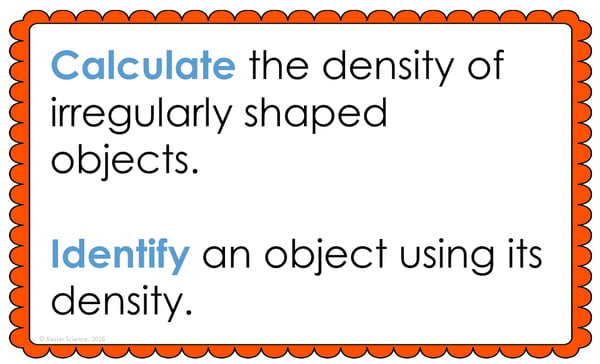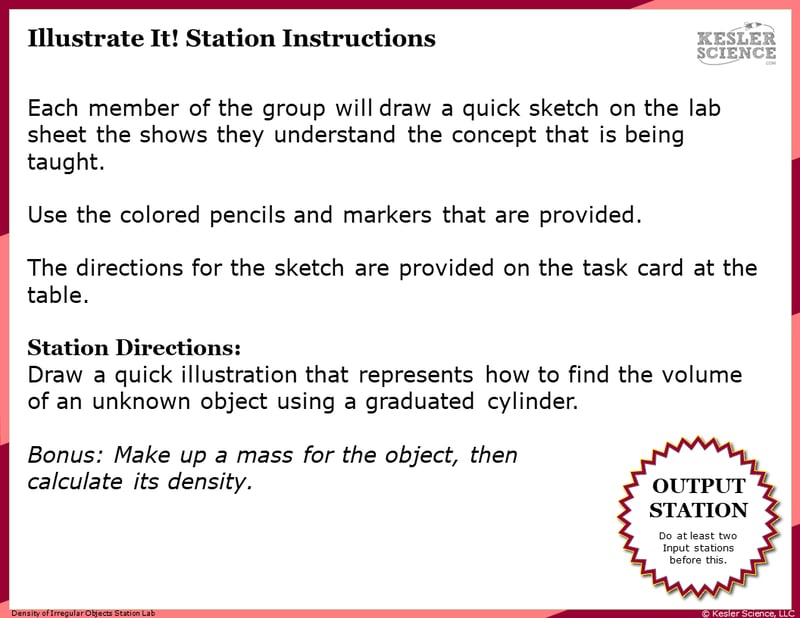Density of Irregularly-Shaped Objects Lesson Plan – A Complete Science Lesson Using the 5E Method of Instruction
By the end of this lesson about the density of irregularly-shaped objects, students will be able to calculate the density of irregularly shaped objects and identify an object using its density. Each of our lessons is designed using the 5E method of instruction to ensure maximum comprehension by the students. This well-thought out unit does the heavy lifting, giving teachers easy-to-implement, highly engaging lesson plans.
This blog will walk you through each of the steps and activities from the Density of Irregularly-Shaped Objects 5E Lesson Plan.
ENGAGEMENT
Objective Introduction
At the beginning of the lesson, the class will do a Think-Pair-Share to discuss the objective.
Class Activity
Have each liquid in 50 ml beakers so students can see what it looks like and how it acts in the beaker. Practice pouring substances as some will dissolve in others.
- Hold up each beaker and have the class describe its physical properties.
- Ask the students if one liquid can float on another.
- Ask them to think about products at home that float on other liquids.
- Hold up the oil and water and ask students if they think one will float on the other. Do not tell students the answer.
- Have one student choose which liquid to place in the graduated cylinder first.
- Pour that liquid carefully down the side of the graduate then add the second liquid.
- Ask students if their hypothesis on which would float on the other was correct.
Student Activity
- Have students make a list of the how the liquids will layer.
- Ask them to justify their choices.
- Ask one student to give you their list. As they list the liquids pour each one into the graduate.
- Have students compare their list with the results shown in the graduate.
- Discuss what makes one liquid float on another.
- Explain that over the next few days, students will be learning about density and how it is used to identify unknown substances.

The teacher will then help to clear any misconceptions their students may have about the density of irregularly-shaped objects. A common but major misconception, for example, is that students will believe lighter objects float above or in heavier objects because of their weight instead of their density because they don't yet understand the difference between weight and density.
Estimated Class Time for the Engagement: 20-30 minutes
EXPLORATION
With nine stations in total, you can introduce the density of irregularly-shaped objects to your middle school students in a variety of ways! Four of these stations are considered input stations where students will learn new information about irregularly-shaped objects, and four of the stations are output stations where students will be demonstrating their mastery of the lesson's material. A bonus station offers challenges for your early finishers and independent learners. You can read more about how I set up the station labs here.
Watch It!
At this station, students will be watching a short video explaining how Archimedes discovered how to determine the volume of objects accidentally while taking a bath. Students will then answer some questions relating to the video and record their answers on their lab station sheet. For example: What was the problem Archimedes had to solve? How did Archimedes first realize he may have an answer to the problem? What does the term displacement mean?
Read It!
This station will provide students with a one-page reading about the density of rocks. In the reading, students will learn about how density is not easily calculated. Geologists have to use the displacement method on certain minerals to find their densities. There are four follow-up questions that the students will answer to demonstrate their comprehension of the reading material.
Explore It!
Students will be working in pairs to better understand how to calculate the density of irregularly-shaped objects. Students will use a triple beam balance, and a graduated cylinder to determine the volume and mass of those objects. Students will use this information to determine the density of the objects.
Research It!
The research station will allow students to interact with a simulation and calculate the density of irregularly shaped objects. Students will be directed to follow steps on the task cards to calculate the density of certain minerals by displacement and gathering its mass.
Organize It!
The Organize It station allows your students to organize four different irregular-shaped objects with their densities. Students will use the mass and volumes, using the displacement method, given to determine which correct density card to match up with.
Illustrate It!
Your visual students will love this station. Students will draw a quick illustration that represents how to find the volume of an unknown object using a graduated cylinder.

Write It!
Students who can answer open-ended questions about the lab truly understand the concepts that are being taught. At this station, the students will be answering three task cards: Explain in your own words how to find the volume of an irregular shaped object. What tools could you use if the irregular shaped object is too big to fit into a graduated cylinder? Why would it be important for shipbuilders to understand the principle of density and buoyancy?
Assess It!
The Assess It station is where students will go to prove mastery over the concepts they learned in the lab. The questions are set up in a standardized format with multiple choice answers. Some questions will ask students: What is the volume of the rock? What is the density of rock #1? What is the density of rock #2?
Challenge It! - Bonus Station
Early finishers and advanced students will love the extension activities in this station. Four activity choices offer them ways to expand their learning through mini-games and mini-projects.
Estimated Class Time for the Exploration: One or two 45-minute class periods
EXPLANATION
The explanation activities will become much more engaging for your class once they’ve completed the exploration station lab. During the explanation piece of the lesson, the teacher will be clearing up any misconceptions their students may have about the density of irregularly-shaped objects with a variety of materials. These materials include on-level and modified versions of the interactive presentation (may be used individually or projected), anchor charts, and paper or digital interactive notebook activities. If you have students that need modified notes, the 5E lessons come equipped to help give every student access to the lesson.
Interactive notebook samples: Above-left is a digital INB activity slide; above-right is an example of the paper INB activities.
The students will also be interacting with their journals using INB templates for the density of irregularly-shaped objects. Each INB activity is designed to help students compartmentalize information for a greater understanding of the concept. The density of irregularly-shaped objects INB templates allows students to focus their notes on the definition of density, Archimedes, how you can tell if an object will sink or float in water.
Estimated Class Time for the Exploration: Two or three 45-minute class periods
ELABORATION
The elaboration section of the 5E method of instruction gives students choices that allow them to prove they’ve mastered the concepts behind the lesson. When students are given a choice, they’re much more enthusiastic and invested in the project than they are when their teachers choose their projects for them. There are a total of nine choices to demonstrate understanding of how to calculate the density of irregularly-shaped objects. A separate set of choices that offer more teacher support are also available for students that need them. Rubrics guide students to doing their best work and assist in grading

Estimated Class Time for the Elaboration: Two or three 45-minute class periods (can also be used as an at-home project)
EVALUATION
The final piece of the 5E model is to evaluate the students' comprehension. Included in every 5E lesson is a homework assignment, assessment, and modified assessment. Research has shown that homework needs to be meaningful and applicable to real-world activities in order to be effective. When possible, I like to give open-ended assessments to truly gauge the student’s comprehension.
Estimated Class Time for the Elaboration: One 45-minute class period
DOWNLOAD THE FULL LESSON NOW
Download Over $100 in FREE Resources
For Middle School Science
Simply create a login below and gain immediate access to a selection of our Kesler Science product line worth $100 - for FREE. There's a full version of every product type! You'll also join tens of thousands of middle school science teachers who receive timely tips and strategies straight to their inbox.







